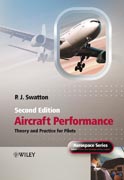
In the last seven years, many of the regulations regarding civil aviation have changed. This new revised edition of the standard reference used in aviationflight schools includes all the latest JAA regulations and requirements, giving aspiring pilots what they need to pass the JAA exam, while also keeping flight operators fully briefed on the newest JAA rulings. Divided into three parts, the book covers the aerodynamic theory for each phase of flight, scheduled performance theory, and practical aspects of aeroplane performance. With 622 test questions and answers, as well as 25 consolidation exercises, spread over 18 chapters, here is the premier study guide for pilots in training. INDICE: Preface Acknowledgements List of Abbreviations Weight and Mass Introduction PART 1 AERODYNAMIC THEORY 1 Preliminaries 1.1 Air Density 1.2 Speeds1.3 Engine Performance Self-Assessment Exercise 1 2 Level Flight Aerodynamics2.1 Stability 2.2 Angle of Attack and Pitch Angle 2.3 The Four Forces 2.4 Mass 2.5 Lift 2.6 Drag 2.7 Analysis of the Total Drag Curve 2.8 The Effect of theVareables on Drug 2.9 The CL v CD Polar Diagram 2.10 Analysis of the Lift/Drag Ratio 2.11 Thrust 2.12 Analysis of the Thrust Curves 2.13 The Effect of the Variables on Thrust 2.14 Power 2.15 Analysis of the Power Curves 2.16 The Effect of the Variables on Power 2.17 Summary Self-Assessment Exercise 2 3 Take-off and Climb Aerodynamics 3.1 Take-off 3.2 The Effect of the Variables on Take-off 3.3 Climbing Flight 3.4 The Effect of the Variables on the Climb 3.5 ClimbGradient 3.6 Rate of Climb 3.7 Aircraft Ceiling 3.8 Climb Regimes Self-Assessment Exercise 3 4 Cruise Control 4.1 Specific Air Range (SAR) 4.2 Buffet 4.3 The Buffet Onset Boundary Chart 4.4 Cost Index 4.5 Turns 4.6 Types of Cruise 4.7 Range and Endurance: General 4.8 Cruise Techniques for Piston-engined Aeroplanes 4.9 Cruise Techniques for Turbo-prop Aeroplanes 4.10 Cruise Techniques for Jet Aeroplanes 4.11 Summary Self-Assessment Exercise 4 5 Descent Aerodynamics 5.1 The Forces in a Descent 5.2 Gliding for Maximum Range 5.3 Gliding for Maximum Endurance 5.4 Descent Regimes Self-Assessment Exercise 5 PART 2 Scheduled Performance Theory 6 Performance Planning 6.1 Regulations and Requirements 6.2 The Performance Class System 6.3 Performance Legislation 6.4 Aeroplane Performance Levels 6.5 Performance Planning 6.6 Altimeter Corrections 6.7 Flight Manuals 6.8 Performance Calculations and Limitations 6.9 Noise Abatement Procedures Self-Assessment Exercise 6 7 Aerodrome Geometry 7.1 Field Lengths Available 7.2 Take-off Run Available (TORA) 7.3 Obstacles 7.4 Stopway 7.5 Accelerate/Stop Distance Available (ASDA) 7.6 Clearway 7.7 Take-off Distance Available TODA 7.8 Balanced and Unbalanced Field Lengths 7.9 Field-Length-Limited Take-offMass Calculations 7.10 Runway Alignment Reduction 7.11 Runway Slope Calculation 7.12 The Effect of Runway Slope on Obstacle Calculations 7.13 Landing Distance Available (LDA) 7.14 Runway End Safety Area (RESA) Self-Assessment Exercise 7 8 Runway Surfaces 8.1 Aerodrome Pavement Strength 8.2 The Pavement Strength Reporting System 8.3 Aircraft Classification Number (ACN) 8.4 Contaminated Surfaces 8.5 Braking Coefficient of Friction 8.6 Surface Contaminants 8.7 The Effect of Runway Contamination 8.8 Hydroplaning Self-Assessment Exercise 8 9 The Variables 9.1 Air Density 9.2 Wind Component 9.3 Aeroplane Flap Setting 9.4 Aeroplane Mass 9.5 Runway Slope and Surface 9.6 Miscellaneous Variables 9.7 The Maximum Take-off Mass 9.8 Calculations Self-Assessment Exercise 9 10 Speeds 10.1 General 10.2 Summary 10.3 Stalling Speeds 10.4 Take-off Speeds 10.5 V Speeds and Take-off Field Lengths 10.6 Climb Speeds 10.7 Control Speeds 10.8 Landing Speeds 10.9 Other Significant Speeds 10.9.1 VFE 10.9.2 VFO 10.9.3 VMO/MMO 10.9.4 VNE 10.9.5 VP Self-Assessment Exercise 10 PART 3 Scheduled Performance Practice 11 Class B Take-off 11.1 General Regulations 11.2 Take-off Speeds 11.3 Take-off Requirements 11.4 Take-off Distance Requirements 11.5 Class B Take-off Calculations Self-Assessment Exercise 11 12 Class B Take-off Climb 12.1 General Requirements 12.2 Climb Minimum-Gradient Requirements 12.3 Obstacle Clearance Requirements 12.4 Take-off Climb Calculations 12.5 Climb Calculations SEP1 B En-route and Landing 13.1 En-route 13.2 Landing Self-Assessment Exercise 13 14 Class A: Take-off Theory 14.1 General Regulations 14.2 Field-Length Requirements 14.3 Class A FLL TOM Analysis 14.4 Field-Length Requirements Analysis14.5 Rapid Calculation Methods Self-Assessment Exercise 14 15 Take-off Calculations 15.1 Field-Length-Limited Take-off Mass 15.2 The Aeroplane Flight Manual (AFM) 15.3 CAP 698 Section 4 15.4 Take-off Mass and Distance Calculations 15.5 Take-off Abnormalities 15.6 The Maximum Take-off Mass Self-Assessment Exercise 15 16 Class A Take-off Climb 16.1 The Take-off Climb Requirements 16.2 TheRelationship of NFP to GFP 16.3 Climb-Limited TOM 16.4 MRJT Climb-Limited TOMCalculations 16.5 Obstacle Clearance 16.6 MRJT Obstacle-Limited TOM Calculation 16.7 Planned Turns 16.8 The Performance-Limited Take-off Mass Self-Assessment Exercise 16 17 Class A En-Route 17.1 En-route Required Navigation Performance 17.2 Descent Gradient Diminishment Requirements 17.3 Terminal Aerodromes 17.4 En-Route Requirements for all Class A Aircraft 17.5 En-Route Requirements for Three and Four-engined Aircraft 17.6 En-Route Requirements for Twin-enginedAircraft 17.7 Maximum Distance from an Adequate Aerodrome (Non-ETOPS Aeroplanes) 17.8 ETOPS Aeroplanes 17.9 Obstacle Clearance Requirements: All Class A Aeroplanes 17.10 Ceilings 17.11 Drift-Down Technique 17.12 Stabilizing Altitudes17.13 Route Profile Comparisons 17.14 En-route Alternate Aerodromes 17.15 Fuel Jettisoning 17.16 En-route Calculations Self-Assessment Exercise 17 18 ClassA Landing 18.2 The Landing Field-Length Requirements 18.3 Approaches 18.4 Short-field Landings 18.5 The Climb-Limited Landing Mass 18.6 Climb-Limited Landing Mass Calculations 18.7 Normal Field-Length Limited Landing Mass Calculations 18.8 Scheduled Landing Mass Calculations 18.9 The Quick Turnaround Limit Self-Assessment Exercise 18 PART 4 CONCLUSION 19 Definitions 19.1 Speeds 19.2 Distances 19.3 Altitude, Elevation and Height 19.4 Weight and Mass 19.5 ETOPS 19.6 Obstacles 19.7 Performance 19.8 Power Unit(s) 19.9 Surfaces and Areas 19.10 Temperature 19.11 Formulae used in Performance 20 Answers to Self-Assessment Exercises Self-Assessment Exercise 1 Self-Assessment Exercise 2 Self-AssessmentExercise 3 Self-Assessment Exercise 4 Self-Assessment Exercise 5 Self-Assessment Exercise 6 Self-Assessment Exercise 7 Self-Assessment Exercise 8 Self-Assessment Exercise 9 Self-Assessment Exercise 10 Self-Assessment Exercise 11 Self-Assessment Exercise 12 Self-Assessment Exercise 13 Self-Assessment Exercise 14 Self-Assessment Exercise 15 Self-Assessment Exercise 16 Self-Assessment Exercise 17 Self-Assessment Exercise 18 Bibliography Index
- ISBN: 978-0-470-77313-0
- Editorial: John Wiley & Sons
- Encuadernacion: Rústica
- Páginas: 384
- Fecha Publicación: 25/07/2008
- Nº Volúmenes: 1
- Idioma: Inglés
